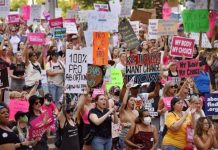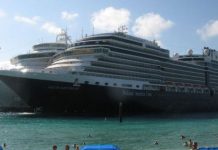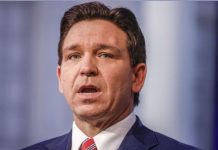
Sept. 10 (UPI) — Hurricane Irma left three people dead and 1.6 million in Florida without electricity Sunday morning after the Category 4 storm made landfall in the Keys.
The storm reached Cudjoe Key in the lower Florida Keys at 9:10 a.m., the National Hurricane Center said. The storm was skirting the state’s west coast and was forecast to make another landfall near Fort Myers and Naples as a Category 3 storm around 8 p.m. Sunday.
In Monroe County, which encompasses Key West, one man died after he lost control of a truck that carried a generator, local officials said. And two other people died in a car crash in the rain in Hardee County, which is about 60 miles inland from Sarasota, the Florida Highway Patrol said.
Irma, which strengthened to 130 mph as a Category 4 overnight, had gusts of 93 mph near Key Largo and 89 mph at Key West International Airport. Irma is the strongest storm to hit the Florida Keys since Donna 57 years ago.
“It’s wicked, this is unbelievable,” Vic Lamorte, said at 7:45 a.m. to the Sun Sentinel in a hurricane-shuttered, three-story concrete house in Tavernier in the Middle Keys. “When I say whipping, I mean it’s whipping outside. And it’s howling, unbelievable howling.”
The Keys are “getting pounded,” Florida Gov. Rick Scott told ABC News’ George Stephanopoulos on This Week. “They’re going to have 130 mph winds. They’re going to have 10 to 25 inches of rain. … And then on top of that, the potential of 15 [feet] of storm surge.”
And more than a million without power.
As of 11:30 a.m., Florida Power & Light, the state’s main electric power, reported there were 418,870 outages in Broward, 177,900 in Palm Beach County and 657,320 in Miami-Dade. On the west coast, 25,610 outages were listed in Collier.
FPL estimated 3.4 million out of its 5 million accounts — a total of 5 million people — could be without power at some point during Irma, the company’s largest number of outages in history.
“We think this could be the most challenging restoration in the history of the U.S.” company spokesman Chris McGrath said.
Most of the Keys, which is not served by FPL, was without power.
Keys Energy Services reported more than 27,000 customers without power and Florida Keys Electric Cooperative Association said 17,000 customers were without power.
Miami Dade County Mayor Carlos Gimenez said three-quarters of the county was without power Sunday afternoon. He ordered a 7 p.m. county “for the safety of our residents.”
Irma’s dangerous winds knocked down trees and downpours flooded streets.
In downtown Miami, a construction crane cracked and fell. The crane was across from the Federal Prison and no injuries were reported, Rick Seara with the City of Miami, said.
Gideon J. Apé he heard “a crack and then a boom.”
And even in areas where the full force of the hurricane hasn’t yet been felt, the storm has caused destruction. In Palm Bay, about 70 miles northeast of Orlando on the coast, a potential tornado destroyed six mobile homes, the police department there said. No injuries were reported.

Most of the state was under a hurricane warning.
“Hurricane Irma is a massive storm with effects that will be felt across the entire South Florida peninsula,” the National Weather Service said in a report issued at 5:38 a.m. Sunday.
The hurricane prompted state officials to order 6.6 million — a third of the population — to evacuate, causing massive backups on the northbound roads out of the state. And gas became scarce.
Those who stayed in the state hunkered down as curfews were ordered throughout the area.
Counties on the east coast instituted curfews Saturday and west coast cities have ordered them before Sunday night.
The roads were deserted and businesses were closed. Even police officers were ordered off the streets Sunday.
Because of mandatory evacuations, people filled shelters across South Florida.
More than 72,000 people were in than 390 shelters across the state, the governor’s office said.
Storm surge was a big concern.
“You can’t survive these storm surges,” Florida’s governor said.
In Fort Myers, where the storm was expected to hit a second time, storm surge warnings were in effect.
“It’s one of the worst situations that we had hoped for,” Bill Moss, Naples’ city manger, told CNN. “The storm surge now is going to be our biggest concern.”
Up the Atlantic Coast from North Miami Beach to the Jupiter Inlet, storm surge warnings were discontinued. A few days ago the storm was predicted to more impact that area and the eye was to pass over the region. But the east coast will be spared a direct hit.
However, tornadoes were reported in the region.
The National Weather Service said a “large and dangerous tornado” swept west through central Broward County toward the Everglades on Saturday night. The weather service issued tornado warnings across Broward, Miami-Dade and Palm Beach counties.
Farther north in Martin County, sheriff’s office Marine Units attempted to rescue two people on a vessel in the ocean.
Across South Florida, schools and businesses have been closed since Thursday.
The governor shut all public schools and state offices on Friday and Monday. And some school districts are not planning to open Tuesday.
Airports throughout the state were shut down by Friday, and Greyhound, Amtrack and local rails stopped service. Cruise lines also canceled cruises.
And Disney and Universal theme parks in Orlando closed before the arrival of Irma.

The Caribbean
Before Irma made landfall in the Florida Keys on Sunday morning, the hurricane caused more than $10 billion in damage in several locations throughout the Caribbean, disaster risk experts told the BBC.
At least 27 people died and thousands were left without homes.
The hurricane struck land as a Category 5 storm Wednesday in Barbuda, and then passed through St. Martin and Anguilla. Damage was limited in Puerto Rico, although much of the population of 3.4 million lost electrical power and at least 56,000 were without water.
Barbuda, an island which forms the nation of Antigua and Barbuda, was the first island hit by the hurricane, and lost about 95 percent of its buildings, Prime Minister Gaston Browne said Thursday. About 50 people were injured on St. Martin, where the Dutch portion of the island saw significant looting after the hurricane passed, Dutch Prime Minister Mark Rutte’s office reported.
Communication to the many of the islands was lost in the storm, and damage assessments are slow.
“We can’t yet assess the full extent of damage, but we expect that the Red Cross will be delivering extensive support to many thousands over the coming weeks and months,” commented Walter Cotte, Red Cross regional director.
Some of these islands, like Barbuda, were projected to be in the path of Category 4 Hurricane Jose, but the powerful storm’s path adjustednorthward.






